- Home
- News
- Talk Round' Town
- The Golden Era of Parallel Cinema
The Golden Era of Parallel Cinema
 Comments [ 0 ] By Gurprit K. | 06 April 2015 | 9:42pm
Comments [ 0 ] By Gurprit K. | 06 April 2015 | 9:42pm

Parallel cinema, a blanket term for cinema known often for its realistic content and absence of all the glamour that drives mainstream films, originated somewhere around the 1920s and took shape between the 40s and 60s. Satyajit Ray is perhaps regarded as the pioneer of the movement but filmmakers before him had already started making movies that were hailed as milestones, the earliest being V. Shantaram's silent film Sawkari Pash (1925). In truth, the pioneer of the movement were the different state governments that provided financial support to filmmakers who sought to deliver films that were neither totally political, nor theatrical and not really "art" but somewhere in between. Let us look at the origin and the growth of the movement and some of the best movies it gave birth to.
 There is a scene of a dog howling near a
hut in Sawkari Pash. As regular as it probably seems
today, it was hailed as a breakthrough and made way for film-makers who sought
to infuse a touch of "realism" in their movies. Issues of the day
began to pave their way into the films. One example of such hit
film is Achhut Kanya (1936). Starring Devika Rani and
Ashok Kumar and directed by Franz Osten, it is the story of two friends - Pratap
(Ashok Kumar) and Kasturi (Devika Rani) - in love with each other. However, there is one
problem, Ashok is a Brahmin while Kasturi is an untouchable. The film
highlights the caste issue in India that seeps into every aspect of social
life and still exists to this date. Given the limits of technology in those days, the
film remains a magnificent piece of work.
There is a scene of a dog howling near a
hut in Sawkari Pash. As regular as it probably seems
today, it was hailed as a breakthrough and made way for film-makers who sought
to infuse a touch of "realism" in their movies. Issues of the day
began to pave their way into the films. One example of such hit
film is Achhut Kanya (1936). Starring Devika Rani and
Ashok Kumar and directed by Franz Osten, it is the story of two friends - Pratap
(Ashok Kumar) and Kasturi (Devika Rani) - in love with each other. However, there is one
problem, Ashok is a Brahmin while Kasturi is an untouchable. The film
highlights the caste issue in India that seeps into every aspect of social
life and still exists to this date. Given the limits of technology in those days, the
film remains a magnificent piece of work.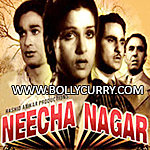 Another such example is Chetan Anand's Neecha Nagar (1946). The film is also of
particular significance due to the fact that it made it to the international circuit and
even won the Grand Prize at the debut Cannes Film Festival. Since then, Indian
films frequently made it to all the different international film festivals. It
also marked an important thread of parallel cinema - the influence of Indian
literature on films. Neecha
Nagar, based on a Hindi story
by Hayatulla Ansari, takes a look at the difference between the rich and the
poor in society. The wealthy landlord lives "high up" on the
mountains while the poor toil in the valley "below". Written by
Khwaja Ahmad Abbas, the film was a pioneering effort. It also marked the debut
of Pandit Ravi Shankar as a music director.
Another such example is Chetan Anand's Neecha Nagar (1946). The film is also of
particular significance due to the fact that it made it to the international circuit and
even won the Grand Prize at the debut Cannes Film Festival. Since then, Indian
films frequently made it to all the different international film festivals. It
also marked an important thread of parallel cinema - the influence of Indian
literature on films. Neecha
Nagar, based on a Hindi story
by Hayatulla Ansari, takes a look at the difference between the rich and the
poor in society. The wealthy landlord lives "high up" on the
mountains while the poor toil in the valley "below". Written by
Khwaja Ahmad Abbas, the film was a pioneering effort. It also marked the debut
of Pandit Ravi Shankar as a music director.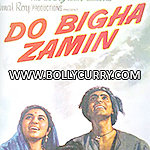 The 50s saw the growth of films that
rejected the absurd musicals that dominated the industry. The era saw certain directors
combining certain features of the aforementioned commercial films and elements of art-house films as well.
One of the best examples is Bimal Roy's Do
Bigha Zamin (1953). It
achieved both critical and commercial acclaim and paved way for the
cinema of 50s and 60s, a period regarded often as the "Golden Era" of
Indian cinema. The story revolves around the lives of farmer Shambu (Balraj
Sahni), wife Parvati (Nirupa Roy) and son Kanhaiya (Rattan Kumar) and their
"do bigha zamin" in a village hit by famine. The film, is regarded as a trend-setter, was inspired by
the Italian film Bicycle
Thieves (1948), the same that inspired Ray's magnum opus Pather Panchali (1955).
The 50s saw the growth of films that
rejected the absurd musicals that dominated the industry. The era saw certain directors
combining certain features of the aforementioned commercial films and elements of art-house films as well.
One of the best examples is Bimal Roy's Do
Bigha Zamin (1953). It
achieved both critical and commercial acclaim and paved way for the
cinema of 50s and 60s, a period regarded often as the "Golden Era" of
Indian cinema. The story revolves around the lives of farmer Shambu (Balraj
Sahni), wife Parvati (Nirupa Roy) and son Kanhaiya (Rattan Kumar) and their
"do bigha zamin" in a village hit by famine. The film, is regarded as a trend-setter, was inspired by
the Italian film Bicycle
Thieves (1948), the same that inspired Ray's magnum opus Pather Panchali (1955).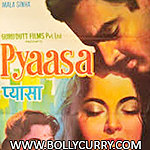 Another film of the same thread is Guru
Dutt's Pyaasa (1957), a classic that among many
things was featured in the list of All-Time 100 Best Movies by Time
Magazine. It is the story of Vijay (Guru Dutt), a struggling poet whose
work is ridiculed as waste by both publishers and relatives until he
meets a
kind hearted woman in Gulabo (Waheeda Rehman), a prostitute. She falls
in
love with him and his poetry, and helps him get his poetry published. In
the
end, after having seen enough of the hypocrisy and deceit around him, he
leaves with Gulabo to start a new life. The film received widespread
fame, has
a cult following in France and Germany and has been screened in many
countries over the world to outstanding success.
Another film of the same thread is Guru
Dutt's Pyaasa (1957), a classic that among many
things was featured in the list of All-Time 100 Best Movies by Time
Magazine. It is the story of Vijay (Guru Dutt), a struggling poet whose
work is ridiculed as waste by both publishers and relatives until he
meets a
kind hearted woman in Gulabo (Waheeda Rehman), a prostitute. She falls
in
love with him and his poetry, and helps him get his poetry published. In
the
end, after having seen enough of the hypocrisy and deceit around him, he
leaves with Gulabo to start a new life. The film received widespread
fame, has
a cult following in France and Germany and has been screened in many
countries over the world to outstanding success. The 1960s saw the growth of
"middle" cinema and reached to wider audiences in the 70s. Pioneers
like Gulzar, Shyam Benegal and Saeed Akhtar Mirza accepted and embraced to
great success certain elements of conventional cinema. Shyam Bengal's first
feature film Ankur (1974) opened to critical acclaim
and brought to the fore Shabana Azmi and Anant Nag. The movie is the story of Laxmi
who lives with her deaf and mute husband, Kishtayya, until one day Surya, the
son of the landlord, arrives in the village. He has an affair with Laxmi when
Kishtayya leaves but throws her out when she gets pregnant. Kishtayya returns
and has him publicly beaten but Laxmi rushes to his defence. She curses Surya
and returns home with Kishtayya. In the final scene, a child throws a stone at
Surya's glass window, signifying the "seedling" (ankur) of
revolution.
The 1960s saw the growth of
"middle" cinema and reached to wider audiences in the 70s. Pioneers
like Gulzar, Shyam Benegal and Saeed Akhtar Mirza accepted and embraced to
great success certain elements of conventional cinema. Shyam Bengal's first
feature film Ankur (1974) opened to critical acclaim
and brought to the fore Shabana Azmi and Anant Nag. The movie is the story of Laxmi
who lives with her deaf and mute husband, Kishtayya, until one day Surya, the
son of the landlord, arrives in the village. He has an affair with Laxmi when
Kishtayya leaves but throws her out when she gets pregnant. Kishtayya returns
and has him publicly beaten but Laxmi rushes to his defence. She curses Surya
and returns home with Kishtayya. In the final scene, a child throws a stone at
Surya's glass window, signifying the "seedling" (ankur) of
revolution.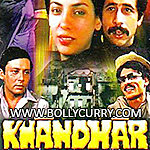 The 80s saw some films that received
unprecedented international success. One such film is Mrinal Sen's Khandhar (1984). Based on a Bengali short
story Telenapota Abishkar by Premendra Mitra, the story
revolves around three friends who visit some ruins where a mother lives
with her daughter, Jamini; she is waiting for the arrival of a cousin who will
marry Jamini. One of the three friends pretends to be the suitor however, the friends
leave when the mother dies, leaving Jamini alone in the ruins. The film was
screened at the 1984 Cannes Film Festival.
The 80s saw some films that received
unprecedented international success. One such film is Mrinal Sen's Khandhar (1984). Based on a Bengali short
story Telenapota Abishkar by Premendra Mitra, the story
revolves around three friends who visit some ruins where a mother lives
with her daughter, Jamini; she is waiting for the arrival of a cousin who will
marry Jamini. One of the three friends pretends to be the suitor however, the friends
leave when the mother dies, leaving Jamini alone in the ruins. The film was
screened at the 1984 Cannes Film Festival.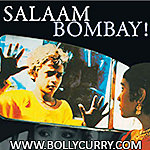 The film that became the second Indian
film to be nominated for the Academy Award for Best Foreign Language Film and
received outstanding acclaim from media and world over was Mira Nair's Salaam Bombay (1988). The hero of the film is
Krishna who acquires the name of "Chaipau" in Bombay where he works for a
travelling circus. One day, his boss asks him to run an errand but when he returns
the circus is gone. He leaves for Bombay and ends up in a red light area. Nair
portrays the characters with amazing sensitivity and warmth. She used hidden
cameras for the film and shot it in the absence of sets, all which helped the sense
of honesty be portrayed remarkably well onscreen. The film won many awards and received several nominations.
The film that became the second Indian
film to be nominated for the Academy Award for Best Foreign Language Film and
received outstanding acclaim from media and world over was Mira Nair's Salaam Bombay (1988). The hero of the film is
Krishna who acquires the name of "Chaipau" in Bombay where he works for a
travelling circus. One day, his boss asks him to run an errand but when he returns
the circus is gone. He leaves for Bombay and ends up in a red light area. Nair
portrays the characters with amazing sensitivity and warmth. She used hidden
cameras for the film and shot it in the absence of sets, all which helped the sense
of honesty be portrayed remarkably well onscreen. The film won many awards and received several nominations.Parallel cinema saw a decline during the
1990s owing to financial constraints. However, it saw a revival again
during the
late 90s. Even keeping its popularity (or lack of it) aside, it is clear
that
it is as much of a force in the industry as commercial cinema (that
brings in
most of the money). It's themes, the focus on the common man and the
issues
depicted will always continue to have universal appeal. Moreover, due to
such films insisting on using actors and not stars, it is responsible
for
much of the talent that graces Indian cinema.
Writer: Tanisha N.
Editors: Fatima W. and Jenifer A.
Graphics: Saraa K.
Editors: Fatima W. and Jenifer A.
Graphics: Saraa K.
Have a suggestion or comment for BollyCurry? Then drop us a PM at BC_Dropbox today!
Copyright BollyCurry
User Rating  (3 Votes)
(3 Votes)
Views 3055
User Comments

If You are a member of India-forums, Then You can also log in here.
Related Videos
- Shabana Azmi joins the ...
- TV actors gear up for ...
- Public Review of Neerja
- Annual Life OK Screen Awards
- Anil Kapoor Launches His ...
- Premiere of Movie 'Issaq'
Highlights Zone
- Tummbad and Andhadhun win BIG at Critics Choice Film Awards!
- 'Kalank' is drop-dead gorgeous (Review)
- Seeking truth can even cost life in India: Shweta
- 'Albert Pinto...' gets new, angrier avatar
- Randeep to work with Mira Nair after 19 years
- 'Albert Pinto Ko Gussa Kyun Aata Hai?': A satire that ruffle feathers (IANS Review, Rating: ***)
- Madhuri's grace in place in 'Kalank' number
- When a masterpiece fails to become one (Column: Bollywood Spotlight)
- Is Bollywood FOOLING the Audience by more of BIOPICS and PATRIOTISM?
 6
6 - The Bollywood Medical Connection












